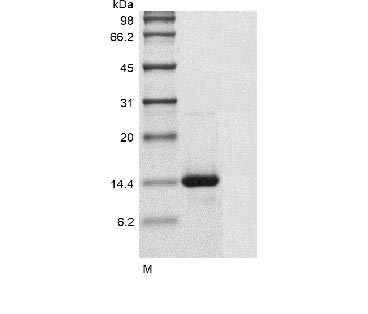Recombinant Human Growth/differentiation factor 6 (GDF6) (Active)
CAT:
399-CSB-AP005971HU-02
Size:
100 µg
Price:
Ask
- Availability: 24/48H Stock Items & 2 to 6 Weeks non Stock Items.
- Dry Ice Shipment: No




Recombinant Human Growth/differentiation factor 6 (GDF6) (Active)
- CAS Number: 9000-83-3
- Gene Name: GDF6_HUMAN
- UniProt: Q6KF10
- Expression Region: 336-455aa
- Organism: Homo sapiens
- Target Sequence: TAFASRHGKRHGKKSRLRCSKKPLHVNFKELGWDDWIIAPLEYEAYHCEGVCDFPLRSHLEPTNHAIIQTLMNSMDPGSTPPSCCVPTKLTPISILYIDAGNNVVYKQYEDMVVESCGCR
- Tag: Tag-Free
- Source: E.Coli
- Field of Research: Signal Transduction
- Assay Type: Active Protein & In Stock Protein
- Relevance: Growth factor that controls proliferation and cellular differentiation in the retina and bone formation. Plays a key role in regulating apoptosis during retinal development. Establishes dorsal-ventral positional information in the retina and controls the formation of the retinotectal map (PubMed:23307924). Required for normal formation of bones and joints in the limbs, skull, digits and aXIal skeleton. Plays a key role in establishing boundaries between skeletal elements during development. Regulation of GDF6 expression seems to be a mechanism for evolving species-specific changes in skeletal structures. Seems to positively regulate differentiation of chondrogenic tissue through the growth factor receptors subunits BMPR1A, BMPR1B, BMPR2 and ACVR2A, leading to the activation of SMAD1-SMAD5-SMAD8 complex. The regulation of chondrogenic differentiation is inhibited by NOG (PubMed:26643732). Also involved in the induction of adipogenesis from mesenchymal stem cells. This mechanism acts through the growth factor receptors subunits BMPR1A, BMPR2 and ACVR2A and the activation of SMAD1-SMAD5-SMAD8 complex and MAPK14/p38 (By similarity).
- Endotoxin: Less than 0.1 EU/µg as determined by LAL method.
- Purity: >95% as determined by SDS-PAGE.
- Activity: Yes
- Bioactivity: Fully biologically active when compared to standard. The ED50 as determined by inducing alkaline phosphatase production of murine ATDC5 cells is less than 2.0 μg/ml, corresponding to a specific activity of > 500 IU/mg.
- Length: Full Length of Mature Protein
- Form: Lyophilized powder
- Buffer: Lyophilized from a 0.2 µm filtered concentrated solution in 30 % Acetonitrile and 0.1 % TFA.
- Reconstitution: We recommend that this vial be briefly centrifuged prior to opening to bring the contents to the bottom. Please reconstitute protein in deionized sterile water to a concentration of 0.1-1.0 mg/mL.We recommend to add 5-50% of glycerol (final concentration) and aliquot for long-term storage at -20℃/-80℃. Our default final concentration of glycerol is 50%. Customers could use it as reference.
- Molecular Weight: 13.6 kDa
- Storage Conditions: The shelf life is related to many factors, storage state, buffer ingredients, storage temperature and the stability of the protein itself. Generally, the shelf life of liquid form is 6 months at -20℃/-80℃. The shelf life of lyophilized form is 12 months at -20℃/-80℃.
